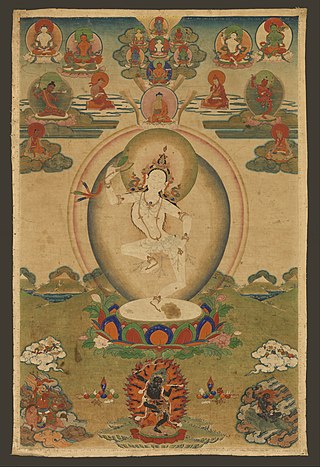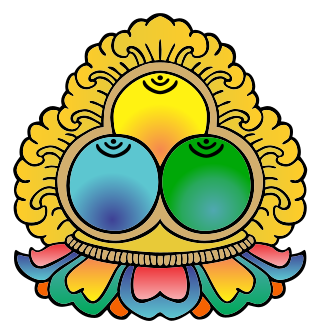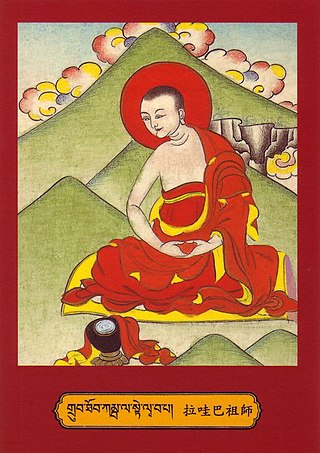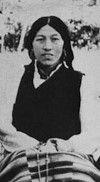
Tibetan Buddhism is a form of Buddhism practiced in Tibet, Bhutan and Mongolia. It also has a sizable number of adherents in the areas surrounding the Himalayas, including the Indian regions of Ladakh, Darjeeling, Sikkim, and Zangnan, as well as in Nepal. Smaller groups of practitioners can be found in Central Asia, some regions of China such as Northeast China, Xinjiang, Inner Mongolia and some regions of Russia, such as Tuva, Buryatia, and Kalmykia.

Pema Chödrön is an American-born Tibetan Buddhist. She is an ordained nun, former acharya of Shambhala Buddhism and disciple of Chögyam Trungpa Rinpoche. Chödrön has written several dozen books and audiobooks, and was principal teacher at Gampo Abbey in Nova Scotia until recently. She retired in 2020.

Tara, Ārya Tārā, also known as Jetsün Dölma, is an important female Buddha in Buddhism, especially revered in Vajrayana Buddhism and Mahayana Buddhism. She may appear as a female bodhisattva in Mahayana Buddhism. In Vajrayana Buddhism, Green Tara is a female Buddha who is a consort of Amoghasiddhi Buddha. Tārā is also known as a saviouress who hears the cries of beings in saṃsāra and saves them from worldly and spiritual danger.

A ḍākinī is a type of goddess in Hinduism and Buddhism.

Jigme Lingpa (1730–1798) was a Tibetan tertön of the Nyingma lineage of Tibetan Buddhism. He was the promulgator of the Longchen Nyingthig, the Heart Essence teachings of Longchenpa, from whom, according to tradition, he received a vision in which the teachings were revealed. The Longchen Nyingthik eventually became the most famous and widely practiced cycle of Dzogchen teachings.

Machig Labdrön, or "Singular Mother Torch from Lab" (1055–1149), was a Tibetan Buddhist nun believed to be a reincarnation of Yeshe Tsogyal, and the renowned 11th-century Tibetan tantric Buddhist master and yogini that originated several Tibetan lineages of the Vajrayana practice of Chöd.

Vajrayoginī is an important figure in Buddhism, especially revered in Tibetan Buddhism. In Vajrayana she is considered a female Buddha and a ḍākiṇī. Vajrayoginī is often described with the epithet sarvabuddhaḍākiṇī, meaning "the ḍākiṇī [who is the Essence] of all Buddhas". She is an Anuttarayoga Tantra meditational deity (iṣṭadevatā) and her practice includes methods for preventing ordinary death, intermediate state (bardo) and rebirth (samsara) by transforming them into paths to enlightenment, and for transforming all mundane daily experiences into higher spiritual paths.
Judith Simmer-Brown is a Distinguished Professor of Contemplative and Religious Studies Emerita at Naropa University. She has expertise in Tibetan Buddhism, Women and Buddhism, Buddhist-Christian dialogue, Western Buddhism and Contemplative Education. She is an acharya — a senior Buddhist teacher — in the Shambhala Buddhist tradition and was a senior student of Chögyam Trungpa Rinpoche. She serves on the board of the Society of Buddhist-Christian Studies, and is on the steering committee of the Contemplative Studies Group of the American Academy of Religion. Previously she was a member of the Lilly Buddhist-Christian Theological Encounter.

Women in Buddhism is a topic that can be approached from varied perspectives including those of theology, history, anthropology, and feminism. Topical interests include the theological status of women, the treatment of women in Buddhist societies at home and in public, the history of women in Buddhism, and a comparison of the experiences of women across different forms of Buddhism. As in other religions, the experiences of Buddhist women have varied considerably.

In Tibetan Buddhism, the Three Jewels and Three Roots are supports in which a Buddhist takes refuge by means of a prayer or recitation at the beginning of the day or of a practice session. The Three Jewels are the first and the Three Roots are the second set of three Tibetan Buddhist refuge formulations, the Outer, Inner and Secret forms of the Three Jewels. The 'Outer' form is the 'Triple Gem', the 'Inner' is the Three Roots and the 'Secret' form is the 'Three Bodies' or trikāya of a Buddha.

Lawapa or Lavapa was a figure in Tibetan Buddhism who flourished in the 10th century. He was also known as Kambala and Kambalapada. Lawapa, was a mahasiddha, or accomplished yogi, who travelled to Tsari. Lawapa was a progenitor of the Dream Yoga sādhanā and it was from Lawapa that the mahasiddha Tilopa received the Dream Yoga practice lineage.

Samantabhadri is a dakini and female Buddha from the Vajrayana Buddhist tradition. She is the consort and female counterpart of Samantabhadra, known amongst some Tibetan Buddhists as the Primordial Buddha. Samantabhadri herself is known as the primordial Mother Buddha. Samantabhadri is the dharmakaya dakini aspect of the Trikaya, or three bodies of a Buddha. As such, Samantabhadri represents the aspect of Buddhahood in whom delusion and conceptual thought have never arisen. As font or wellspring of the aspects of the divine feminine she may be understood as the Great Mother or as an aspect of Prajnaparamita.
Helmut Oehring is a German composer. He was born in East-Berlin, the son of deaf parents. After training as a construction worker, Oehring worked as a cemetery gardener, forest worker, geriatric nurse and stoker. He is self-taught as guitarist and composer. From 1990 to 1992, Oehring studied with Friedrich Goldmann and Georg Katzer at the Academy of Arts, Berlin. He was a fellow of Villa Massimo in 1994/1995. Oering is honorary professor for Théatre musical at the University of the Arts Bern.

Heinz Jakob "Coco" Schumann was a German jazz musician and Holocaust survivor. He became a member of the Ghetto Swingers while transported to Theresienstadt at the age of nineteen. In the aftermath of the Holocaust, Schumann performed as a jazz guitarist, with Marlene Dietrich, Ella Fitzgerald, and Helmut Zacharias.

Niguma is considered one of the most important and influential yoginis and Vajrayana teachers of the 10th or 11th century in India. She was a dakini, and one of the two female founders of the Shangpa Kagyu school of Vajrayana Buddhism, along with dakini Sukhasiddhi. Her birth name was Shrijnana. Like many of the mahasiddhas and Tantric practitioners of the time, Niguma was known by several names both during her lifetime and afterwards. She was called Yogini Vimalashri, or Vajradhara Niguma, or Jñana (wisdom) Dakini Adorned with Bone (ornaments), or The Sister referring to her purported relationship to the great Buddhist teacher and adept Naropa. She was also sometimes called Nigupta, which is explained by the historical Buddhist scholar Taranatha as follows: "The name Nigu accords with the Indian language, which is Nigupta, and is said to mean 'truly secret' or 'truly hidden.' In fact, it is the code-language of the dakinis of timeless awareness."
Jetsunma Mingyur Paldron, or Mingyur Peldrön was a Tibetan Buddhist lama in the Kagyu and Nyingma traditions. She was the daughter of Chögyal Terdag Lingpa, the founder of Mindrolling Monastery. She was a disciple of Gyurme Tekchok Tendzin. She received the entire transmissions of Thug Je Chenpo De Sheg Kun Du from Lochen Dharmashri and mastered the Tsa-lung and Thigle practices at the age of fourteen. In 1717, when the Mongols invaded Tibet, she escaped to Sikkim where she taught the dharma for two years and founded the Pema Yangtse monastery. After the Mongol invasion, she returned to the Tibetan monastery Mindrolling, which had been destroyed, and rebuilt it with her younger brother. She also gave empowerments, oral transmissions, and explanations of the collected works of Chögyal Terdag Lingpa and the Nyingthig Yabzhi to over 270 disciples, as well as establishing Samten Tse nunnery near Mindrolling.

Urgyen Tsomo (1897–1961) was a prominent Tibetan Buddhist female master who was known as the Great Dakini of Tsurphu. She was the consort of the Khakyab Dorje, 15th Karmapa Lama. She was considered by other masters to be the reincarnation (emanation) of Yeshe Tsogyal, the consort of Padmasambhava of the 8th century, who spread Buddhism in Tibet.

Karma Lekshe Tsomo is a Buddhist nun, scholar and social activist. She is a professor at the University of San Diego, where she teaches Buddhism, World Religions, and Dying, Death, and Social Justice. She is co-founder of the Sakyadhita International Association of Buddhist Women and the founding director of the Jamyang Foundation, which supports the education of women and girls in the Himalayan region, the Chittagong Hill Tracts of Bangladesh, and elsewhere. She took novice precepts as a Buddhist nun in France in 1977 and full ordination in Korea in 1982.

Beate Walter-Rosenheimer is a German politician of Alliance 90/The Greens who has been serving as a member of the Bundestag from the state of Bavaria since 2012. Prior to her political career, she worked as a freelance psychologist. In parliament, she has served on various committees and was her parliamentary group's spokesperson for youth policy, education, and training.

Khandro Lhamo was a doctor (Amchi) of Traditional Tibetan medicine and a practitioner of Tibetan Buddhism. She was Dilgo Khyentse Rinpoche's partner and she helped to build and maintain Shechen Monastery in Nepal.

















